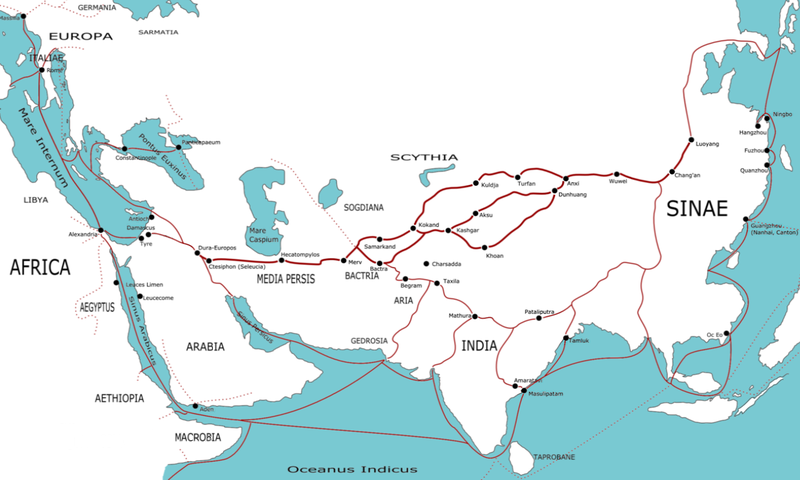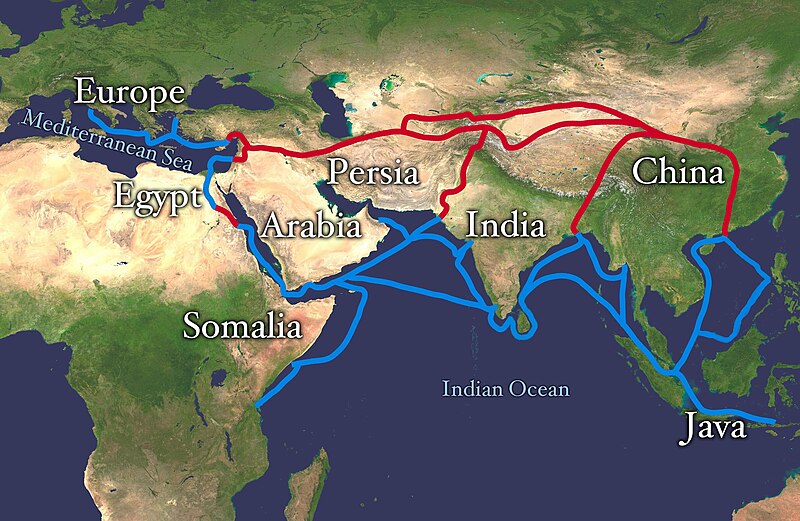مطالعات خلیج فارس
ایران را بشناسید تا ایران را بیشتر دوست بداریدمطالعات خلیج فارس
ایران را بشناسید تا ایران را بیشتر دوست بداریدold sea routes
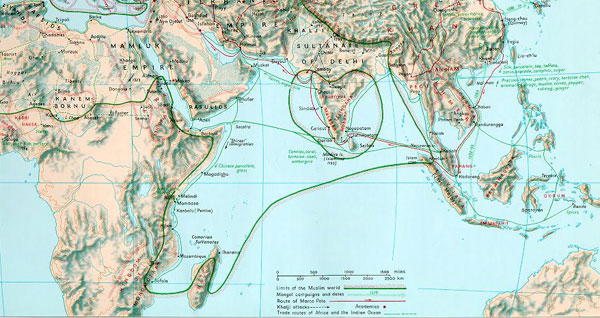 The
Sea Route, showing how the trade of goods extended from China's Han
Dynasty through the old spice routes and the Straits of Malacca, around
Sri Lanka and Western India, both delivering and collecting cargo, then
across the Arabian sea to the Middle East and East Africa. Java,
Sumatra, Malaysia and the ancient Khmer, Thai, Lao Viet and Burmese
civilizations all grew wealthy from the Sino-Indian and were settled by
Indian and Chinese merchants
The
Sea Route, showing how the trade of goods extended from China's Han
Dynasty through the old spice routes and the Straits of Malacca, around
Sri Lanka and Western India, both delivering and collecting cargo, then
across the Arabian sea to the Middle East and East Africa. Java,
Sumatra, Malaysia and the ancient Khmer, Thai, Lao Viet and Burmese
civilizations all grew wealthy from the Sino-Indian and were settled by
Indian and Chinese merchants
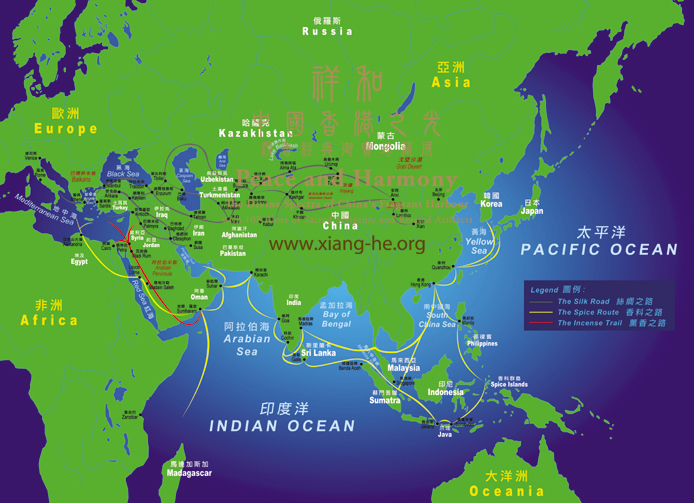
Map of The Silk Road, The Spice Route & Incense Trail
The History of Incense and Spices
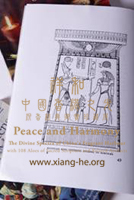 The
development of incense and spices has a long history, with their
earliest use found in the Mesopotamian Civilization several thousand
years ago. According to ancient documentation, as much as 2.5 tonnes of
frankincense were burnt in the Temple of Baal in Babylon each year;1
and there were inscriptions about incense offerings for gods on the
clay tablets of The Epic of Gilgamesh, “the world's oldest literature”.2
In the Book of Exodus of the Old Testament, there are verses describing
the Lord teaching His people how to make the holy anointing oil and
incense:
The
development of incense and spices has a long history, with their
earliest use found in the Mesopotamian Civilization several thousand
years ago. According to ancient documentation, as much as 2.5 tonnes of
frankincense were burnt in the Temple of Baal in Babylon each year;1
and there were inscriptions about incense offerings for gods on the
clay tablets of The Epic of Gilgamesh, “the world's oldest literature”.2
In the Book of Exodus of the Old Testament, there are verses describing
the Lord teaching His people how to make the holy anointing oil and
incense:
“Moreover the LORD spake unto Moses, saying, Take thou also unto thee principal spices…And thou shalt make it an oil of holy ointment, an ointment compound after the art of the apothecary: it shall be an holy anointing oil. And thou shalt anoint the tabernacle of the congregation therewith, and the ark of the testimony…And thou shalt sanctify them, that they may be most holy…And thou shalt speak unto the children of Israel, saying, this shall be an holy anointing oil unto me throughout your generations… And the LORD said unto Moses, Take unto thee sweet spices…these sweet spices with pure frankincense: of each shall there be a like weight: And thou shalt make it a perfume, a confection after the art of the apothecary, tempered together, pure and holy…it shall be unto you most holy...it shall be unto thee holy for the LORD...Whosoever shall make like unto that, to smell thereto, shall even be cut off from his people.”
(Exodus, Chapter 30, verses 22-38) 3
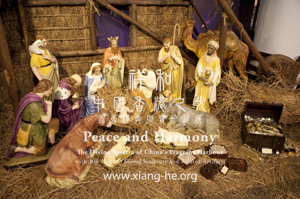 Moreover,
archaeologists discovered pellets of frankincense in the tomb of the
Egyptian Pharaoh Tutankhamun (1341 – 1323 BC). A wall inscription in
Karnak also details the incense offering rituals of Pharaoh Rameses II
before a sacred barge around 1224 BC.1 In fact, incense
culture can be found among different races, including the Phoenicians,
the Arabs, the Indians as well as the Greeks and Romans.4
Moreover,
archaeologists discovered pellets of frankincense in the tomb of the
Egyptian Pharaoh Tutankhamun (1341 – 1323 BC). A wall inscription in
Karnak also details the incense offering rituals of Pharaoh Rameses II
before a sacred barge around 1224 BC.1 In fact, incense
culture can be found among different races, including the Phoenicians,
the Arabs, the Indians as well as the Greeks and Romans.4
The Indian Ocean in Eurasian and African World-Systems before th
The Indian Ocean in Eurasian and African World-Systems before the Sixteenth Century*
PHILIPPE BEAUJARD
Centre
National de la Recherche Scientifique, Centre d'Études Africaines,
École des Hautes Études en Sciences Sociales, Paris, France
|
||||
| Writing of the Mediterranean, Fernand Braudel has remarked, "It isn't water that links its shores," but "seafaring peoples." From a very early date, the Indian Ocean, too, was traversed by sailors, traders, religious men, and migrants moving in search of goods, new lands, or the great unknown. Their movements were shaped by numerous factors, both geographic and social in origin. Over the centuries, these exchanges transformed the Indian Ocean into a unified space.1 Trade —above all, long-distance trade—played a central role in this process. A study of the history of trade networks, together with political and religious factors, allows us to understand the creation of particular societies, as well as the larger area to which they were linked. | 1 | |||
| Trade implies not only an exchange of goods, but also an exchange of knowledge, beliefs, and values. The power of trade to unify, create, and transform cultures can be appreciated only by viewing it from the widest possible angle. The Indian Ocean, our case in point, became a unified space through exchange networks that went far beyond its own borders, reaching from China to Europe and Africa. Gradually over time, transcontinental networks—both maritime and terrestrial—linked the Indian Ocean to the Mediterranean, turning it into a unified zone wherein events and developments occurred interdependently. Therefore, the Indian Ocean should not be considered as a discrete case that underwent processes similar to those of the Mediterranean, as K. Chaudhuri has suggested, but rather as an area that was integrally tied to the Mediterranean. The fact that the different regions of the ancient world united by trade experienced a demonstrable synchronization in their development suggests (but is not yet sufficient proof for) the systemic nature of their relations. | 2 | |||
It is not only the interconnections or the size of the networks but
the regularity, intensity, and speed of the exchanges that resulted in
the different regions being progressively integrated and shaped into a
world-system. This notion was originally conceived by I. Wallerstein in
1974, in a holistic perspective that "looks for an explanation at the
level of the whole." This perspective, which E. Morin has rightly
pointed out the limits of, has not clearly defined the concept of
"system" itself. Before proceeding with the discussion, I should
identify what I mean by the term "system." I follow the definitions
established by Morin, namely, (1) a system represents a "complex unit and the complex of relations between the whole and its parts," (2) a system is made up of cumulative interactions, (3) which constitute the organization of the system.2
The character of this organization is, in essence, both complex and
dynamic. The system generates both order and disorder, unity and
diversity. Taking into account these general characteristics of all
systems and their implications can aid the interpretation of the
available historical data for the Eurasian and African zone. The
systemic approach provides a new "logic," and leads to a new
understanding of world history http://www.historycooperative.org/cgi-bin/justtop.cgi?act=justtop&url=http://www.historycooperative.org/journals/jwh/16.4/beaujard.html | ||||
The Spice Route
The Spice Route was the other great trading route of the Ancient and
Medieval worlds. Spices were carried on the Silk Road also, but the
main source of spices was well south of China, the Spice Islands
(Indonesia), India, and the Malabar (East African) coast. India was at
the center of the world spice trade. It is no accident that Indian food
is known for its spices. Spices were carried to India from the Spice
Islands, sometimes by sea routes. Spices included cassia, star anise,
cloves, coriander, nutmeg, mace, and others. The most vluable spice was
pepercorns. These spices as well as Indian Indian and Africa spices
were then brought by sea to the Middle east by Areab traders. Finally
Venetian or other Italian vessels were bring the spices to Europe.
Rivalry for the sea routes monopolized by Venice increased the
importance of the overland Silk Road. Finally Portuguese sailors in the
15th century established direct contact with the source of spices,
undercutting both the Arabs and Venetians.
Spices
Spices included cardamom, cassia, cinnamon, cloves, coriander,
ginger, mace, nutmeg, star anise, turmeric, and others. The most
vluable spice was pepercorns from the Malabar Coast (south-western
Indian coast) were dried and ground into powdered pepper.
Modern readers often do not appreciate the impotance of spices in the
Ancient and Medieval worlds. It must be understood that food was
usually not very palitable. Not only were there few ways of preserving
foods. Vegetables were unavailable in the Winter and early Spring.
There was no way of storing large quanties of cattle fodder. Thus the
only beef available was salt beef. Even during the Summer meat was
often unpalitable because of the lack of refrigeration to poperly store
it. Many common modern foods were unavailbe to Europeans, including
potatos, corn, tea, coffee, chocolate, bananas, tomatos, oranges,
lemmons, and other foods. Most strikingly, there was no sugar to
sweeten foods, except honey. Thus spices were in great demand to flavor
foods. And modern culinary trends show the imprint. Nutmeg is used in
Italian cooking. Iranian (Persian) cooking has cinnanon-scented
sauces. Steak tartare became popular in Germany. There are gungerm
cloves, and sweet-and-sour touches in Alsatian cooking.
Ancient World
Spices were a valuable trading commodity in antiquity. This means
there were established trading routes in antiquity. Pepercorns were
found in the nose of the mummy of Ramses II. Peper and other spices
were valued commodities in Roman markets. The European trade in these
commodities fell with the economic decline following the fall of Rome
(5th century AD). Another factor was the rise of Islam (7th century
AD). [Turner]
Trading Route
The Spice Route was the other great trading route of the Ancient and
Medieval worlds. Spices were carried on the Silk Road also, but the
main source of spices was well south of China, the Spice Islands
(Indonesia), India, and the Malabar (East African) coast. India was at
the center of the world spice trade. It is no accident that Indian food
is known for its spices. Spices were carried to India from the Spice
Islands by sea routes. The spices as well as Indian Indian and Africa
spices were then brought by sea to the Middle east by Arab traders. The
Arabd purchased spices from the Indians and from Chinese and Javanese
merchants who sailed to Indian ports. Finally Venetian or other Italian
vessels were bring the spices to Europe.
Arabs
The Arabs burst out of the Arabian Desert in the 7th century. The
Arabs cut Europe off from the clove islands. They became the masters of
the spice trade. The Arabs dominated the trade routes from India and
eastern Africa. They kept the sources of spices secret from the
Europeans. The Arabs told fantastic tales of the dangers they faced in
obtaining spices in distant and mysterious lands. Spice trading was
important to Arabs from the very beginning of Islam. Mohammed
(570-???AD) himself married into a spice-trading family when he chose a
wealthy widow. Islamic armies as they moved throughout the Middle East
gained comtrol over the trade routes to Europe as well as in some cases
the very sources of the pices them selves. (Much of the Spice Islands
were conquered by the Arabs, the Islamic Monguls conquered India, and
the Arabs established themselves in Zanzibar and elsewhere in East
Africa).
Italian Trading States
Te European taste for spice began to revive in the 9th century. A
factor here was the rise of the great Italian trading states like Venice
and Genoa. [Turner] The trade was at first limited. Feudal Europe
still gebnerated still limited wealth. The growth of cities and the
rise of the merchant class was just beginning. Arab controlof te trade
roots made spices enormously expensive.
Crusades
Disease
It is believed that the Spice Route is how the bubonic plague reached
Europe. The medieval plague, commonly referred to as the Black Death,
was the most cathestrophic epidemic in recorded history. The plague is
believed to have been brought west from China. Europeans had no
resistance to it in much the same way that smallpox brought by Europeans
was to desimate Native Americans in the 16th and 17th centuries. The
plague ravaged Europe from 1347-51. There were also serious subsequent
outbreaks as well. The plague often killed whole families, in part
because family members could not bring themselve to abandon each other.
Villages were devistated. An estimated 1,000 villages were completely
destroyed. Historians estimate that about one-third of the European
population died in the plague. The plague, however, had a profound
impact on Europe beyond the incalcuable human pain and suffering of
those affected. As strange as it may sound, the plague set in motion
cultural and economic trends that played a major role in shaping modern
Europe.
Venetians
Silk Road
The other great international trading route was the Silk Road. Some
spices were carried on the Silk Road, but much greater quantities were
transported by the Spice Route. The history of the famed Silk Road is
one of many instances in which clothing and fabrics have
played a major role in human history. The story of the silk road is one
of military adventures and conquest, adventuresome explorers, religious
pilgrims, and great philosophers. While it is silk which is often,
naturally enough, most strongly associated with the silk road, the flow
of ideas and religion as an almost unintended aspect of the flow of
trade may have been one of the most significant impacts. Of course most
of the people who traversed the silk road were not great thinkers, but
common tradesmen who transported their merchandise at great risk for the
substantial profits that could be made. They moved cammal caravans over
some of the most hostile terraine on the planet. The ilk road
tranversed deserts, mountains and the seemingly endless Central Asian
steppe. Some of the great figures of history are associated with the
Silk Road, including Alexander the Great, Marco Polo, Genghis Khan, and
Tamerlane. Merchandice may have moved over the Silk Road as early as the
5th century BC. The Silk Road is believed to have become an
established trade route by the 1st century BC and continued to be
important until the 16th century when more reliable sea routes were
established as a result of the
European voyages of discovery.
Marco Polo
Marco Polo traveled to China on the Silk Road, but his account of
his journey included the first factual information available to
Europeans about the actual source of the spices obtained from the Arabs.
He described hot lands where he saw spices growing. He also explained
the key role of India.
Rivalry
Rivalry for the sea routes monopolized by Veniceincreased the importance of the overland Silk Road.
Fall of Byzantium
The Ottomans with the fall of Byzantium gained control of the Black
Sea. They gradually displaced the Venetians in the northern Aegean.
Expansion south into Syria and Egypt further closed lucrative trade
routes to European shipping. The control of territory from the Russian
steppe to Egypt allowed the Ottomons to interdict established European
trade routes to the East. It was this Ottoman control of the spice trade
routes that was a factor in pushing the European voyages of discovery.
European Voyages of Discovery
The account of Marco Polo with actual descriptions of China and the
Spice Islands fueled a desire by Eurpdeans to establish direct trading
links. At the same time Europeans by the 14th century had significantly
imroved their navigational and ship building skills. The astrolabe
helped mariners determine latitude. (Longitude proved a much more
difficult undertaking. The magnetic compass permitted mariners to
determine which direction was north. Great improvements were made in
maps. Here Portuguese cartographers played a key role. Information
provided by travelers was refined by explorers who began to sail south
along the African coast. Europeans also made great strides in
shipbuilding. Large capacity ships called galleons were adopted.
Powered by sail and woth large holds, they greatly reduce the cost of
transporting good over distances. These developments permitted
Europeans them to begin to make voyages od substantial distances and the
goal was to reach the East to develop direct trade contacts with China.
Many of the advances were made by the Itlalian mariners of the eastern
Mediterranean. It was, however, the western European countries of the
Atlantic that would conduct the great voyages of discovery. Finally
Portuguese sailors in the 15th century established direct contact with
the source of spices, undercutting both the Arabs and Venetians. One of
te great disappointments with Columbus and other explorers sailing west
was the failure to find cloves, nutmegs, and other spices. [Turner]


